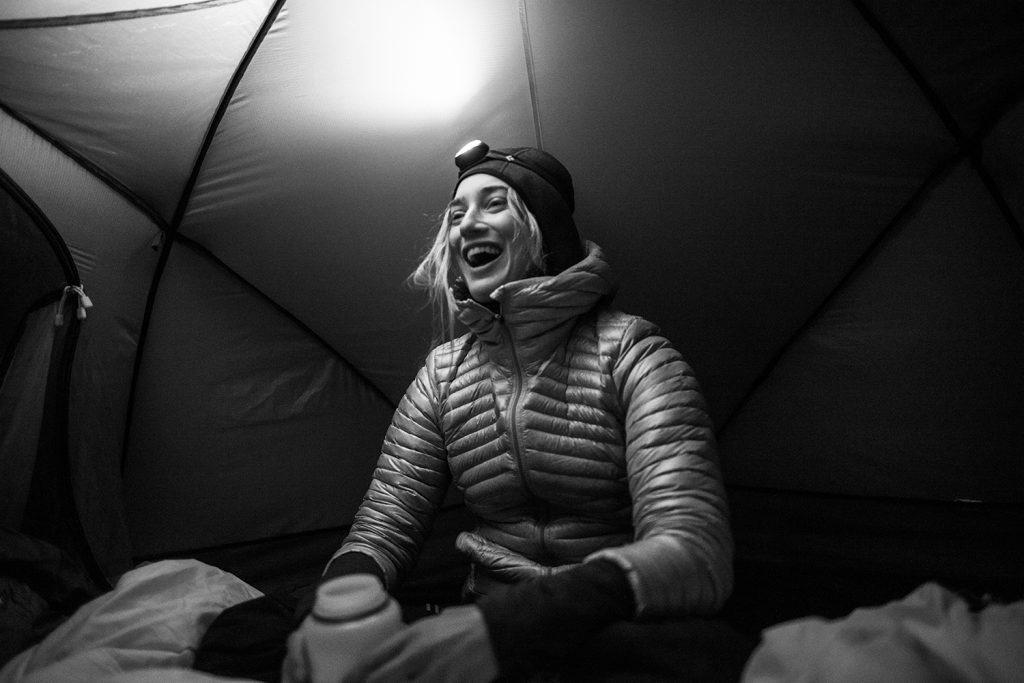When I was first trained to educate customers about layering at the Salem EMS in 1994, I was told to use the acronym “EMS” (external, mid, and skin) as a way to teach new hikers the proper technique. Most outdoor enthusiasts know the benefits of wearing a wicking layer to move sweat away from the skin, insulating mid-layers to create “dead air space” that traps body heat, and a shell jacket to protect us against the heat-stealing effects of wind and rain.
The biggest downside to this “classic” ideology, however, is that the climber keeps their skin and external clothing on throughout the activity, only adjusting the mid-layers as conditions and levels of exertion change. Basically, the external shell must be removed while you add more or subtract internal layers, and taking off the outermost garment in a sub-zero environment has some distinct disadvantages.
First of all, there is the instant heat loss you’ll start to feel. Unnecessary heat loss will have to be replaced by burning more calories, our only source of heat or energy. Ultimately, we want to minimize the drastic cool-down one experiences when shedding their outermost layer, even for just a minute or two.
Second, even the most breathable shell jackets, when we are working hard climbing up a mountain, will start to get a little moist. Think of the area from your outermost layer all the way to your skin as a micro-climate with its own changing conditions. As we become warmer, the humidity in this space is close to 100 percent. As that moist air comes in contact with our outer shell, a portion of it, determined by the fabric’s breathability, travels through the membrane and escapes into the outside air, letting us stay drier longer.
Eventually, we will likely exceed the fabric’s amount of vapor transport potential, and this handy one-way moisture passing will get clogged up. This effect is accelerated in sub-zero temperatures. If one were to measure the heat trapped in each layer of clothing on a warm climber, you would find that those close to the skin are nearly 98.6° F, and the temperature slowly decreases as we work through to our outermost garment. When it is very cold (talking about negative digits here), our shell will be very close to the ambient air temperature, even though we are warm and toasty inside.
Why is this important? Because when that warm humid air that we’ve created through our exertion and then carefully wicked away from our skin and through our mid-layers comes in contact with that sub-zero shell fabric, guess what happens? It is no longer vapor. It freezes on the inside of the shell jacket, effectively inhibiting even the most “breathable” material to keep transporting moisture outside of our little micro-climate. Many winter hikers have witnessed this when they stop to adjust a layer and discover, upon removing their shell jacket, that the inside is lightly coated in frost. If not addressed, this blockage will make your mid-layers damper and damper, until you are a wet, soggy, warm mess. This is a real issue in a cold environment, because we all know how fast a wet person can lose heat.

The Cold-Weather Fix
First, stop adjusting mid-layers. Build your clothing system from the skin out by only ever adding or subtracting on top of what you already have on. This is much faster on the go in the mountains, with the added benefit of eliminating the drastic cool-down that can occur when you stop to add a layer under your shell jacket in -40° F wind chills.
Second, have an insulating layer, preferably with a hood, that fits over everything, including your shell jacket. Wait – over the shell jacket? Yes. This is the single best piece of advice I can share with cold-weather travelers. Remember that micro-climate issue of evaporated sweat condensing when it comes in contact with your sub-zero shell? This is the solution: The shell needs to be warmed up to allow moisture to continue to flow in the right direction.
I’ve had many real-life opportunities to demonstrate this to clients on our Mount Washington winter climbs. A common scenario is, we arrive at Split Rock, just 0.3 miles from the summit. As we’ve been working hard, the inside of my hardshell jacket has a nice layer of frost on it. We take a five-minute break for a bit of water and food, during which we don our “puffy” jackets over everything the second we stop, even though we feel like furnaces from the 4,000-foot climb we just made. The addition of this insulating layer over our warm bodies quickly raises the temperature of that shell jacket to above freezing; then, the frost disappears, the jacket starts “breathing” again, and, when we take the puffy off right before continuing with our journey, we notice that our shell layers are soft and supple again – not frozen and crinkly from internal frost.
Up we go, warm, dry, and within sight of the summit.
David Lottmann
David is a self proclaimed snow & wilderness navigation geek and teaches all aspects of climbing and avalanche safety for Eastern Mountain Sports Schools in North Conway, NH along with seasonal work with our Customer Service Team. He's been with EMS since 1994 and actively blogs at www.NEAlpineStart.com




